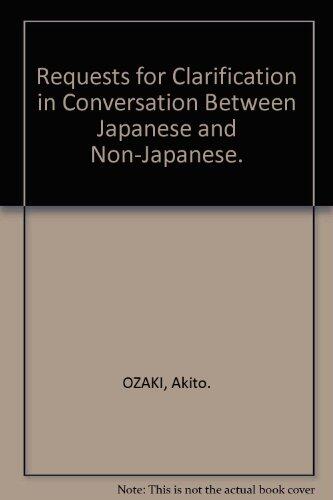
Requests For Clarification In Conversation Between Japanese And Non-japanese
によって
Akito Ozaki
まだ評価がありません
形式
ペーパーバック
ページ数
209
言語
英語
公開されました
Jan 1, 1989
出版社
Dept. Of Linguistics, Research School Of Pacific Studies, The Australian Nat. Univ
ISBN-10
0858833875
ISBN-13
9780858833876
説明
Exploring the intricate dynamics of communication, this work delves into the nuances of requests for clarification in conversations between Japanese speakers and those from other cultural backgrounds. Through a detailed examination of various interactions, the author, Akito Ozaki, sheds light on how different communication styles can lead to misunderstandings or, conversely, foster clearer dialogue.
The study is meticulous in its approach, employing real-life examples to illustrate the complexities that arise during typical conversations. A key focus is on how cultural differences impact the way individuals seek clarity, and how these variations can either bridge gaps or create further confusion. By analyzing specific language patterns and situational contexts, the work provides insights that are invaluable for both linguists and communicators striving for effective cross-cultural interactions.
Ozaki's examination is relevant not just for language learners but also for professionals in international settings. The findings encourage a deeper understanding of conversational dynamics and highlight the importance of context in communication. Ultimately, this research serves as a guide for those navigating the intricate landscape of Japanese and non-Japanese interactions.
In uncovering the layers of conversational requests, this book stands as a significant contribution to the fields of linguistics and cross-cultural communication, advocating for greater awareness and sensitivity in dialogues that span cultural divides.
The study is meticulous in its approach, employing real-life examples to illustrate the complexities that arise during typical conversations. A key focus is on how cultural differences impact the way individuals seek clarity, and how these variations can either bridge gaps or create further confusion. By analyzing specific language patterns and situational contexts, the work provides insights that are invaluable for both linguists and communicators striving for effective cross-cultural interactions.
Ozaki's examination is relevant not just for language learners but also for professionals in international settings. The findings encourage a deeper understanding of conversational dynamics and highlight the importance of context in communication. Ultimately, this research serves as a guide for those navigating the intricate landscape of Japanese and non-Japanese interactions.
In uncovering the layers of conversational requests, this book stands as a significant contribution to the fields of linguistics and cross-cultural communication, advocating for greater awareness and sensitivity in dialogues that span cultural divides.